Break out on your own Dartmoor bouldering adventure to Devon.
Dartmoor National Park sits in the heart of Devon, spanning 368 square miles. Visitors can enjoy this natural playground for a myriad of pursuits.
Dartmoor is fast becoming a favourite bouldering and trad climbing location for many climbers.
Amidst spotting wild Dartmoor ponies and soaking up stunning scenery, you can take on epic problems and climbs.
Read on to discover all you need to know about bouldering and climbing on Dartmoor…
Use these quick links to jump to a different section:
- Introduction to climbing and bouldering on Dartmoor
- Where should you go bouldering or climbing in Dartmoor?
- Things to know before you go
- When is best to go?
- Find Dartmoor climbing experiences to book
- More Dartmoor climbing and bouldering resources
- Find a bouldering bolthole or a climbing cottage!
Climbing and bouldering on Dartmoor
Great for experts and beginners
Climbing and bouldering on Dartmoor is great for beginners and experts in the sport.
The granite tors offer simple problems to start out on, as well as more technical and demanding climbs.
Definition of a Dartmoor tor
A Dartmoor tor is defined as “a high rock or pile of rocks on the top of a hill”, as well as a “rocky peak or hill”.
There’s around 160 tors on Dartmoor, with that number varying, depending on who you ask.
Solo and group climbing opportunities
One of the best things about climbing in Dartmoor is the sheer number and variation of climbing spots.
If you fancy a solo expedition, then you’re sure to find a secluded tor to enjoy all to yourself.
While the multiple routes and climbs on one tor can keep a number of you busy at the same time.
Where should you go bouldering or climbing in Dartmoor?
Haytor Area
The Haytor Area covers the northeastern area of Dartmoor, roughly between Widecombe in the Moor and Lustleigh.
This section of the moor includes Haytor, Hound Tor, Bonehill Rocks and Easdon Tor.
Haytor
Haytor is Dartmoor’s largest tor and is one of the most popular for trad climbing.
It can get quite busy because of its popularity, so it’s something to bear in mind if you’re specifically seeking a quiet climb.
The tor is made up of two separate tors called High Man and Low Man.
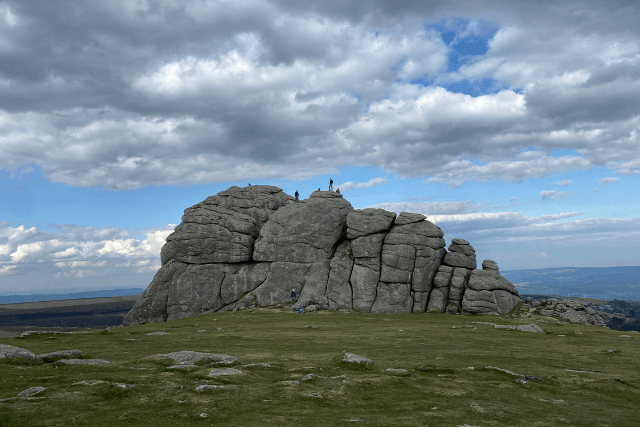
Easier/beginner trad route: Step Across (D) on Haytor West Face
Expert trad route: Aviation (E1 5b) on Low Man
Bonehill Rocks
Bonehill Rocks is the bouldering hub of Dartmoor. There’s over 100 problems to have a go at here.
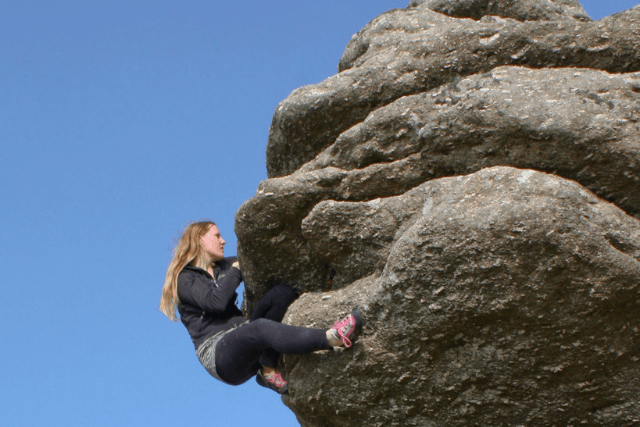
Easier/beginner bouldering route: Warm Up Slab – Left of Crack (V0)
Expert bouldering route: The Wave (Javu P87) (V6)
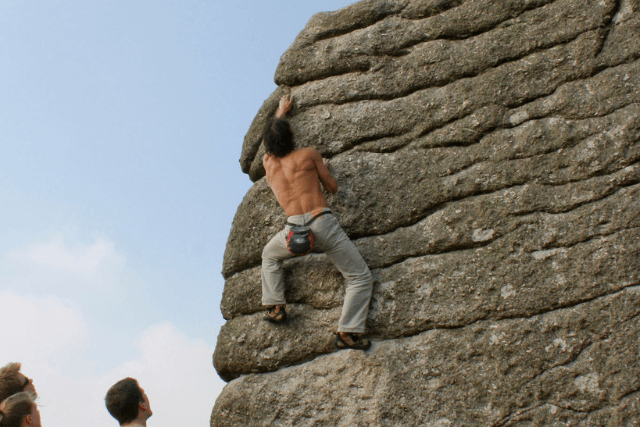
Bovey Valley
Bovey Valley sits in the top northeastern corner of Dartmoor, taking in the Teign Valley and Bovey Woods.
In recent years, climbers have spread out their searches for ever more routes and problems. In their searching, they have come across the granite mounds hidden in wooded valleys on Dartmoor.
Now there are over 1,000 problems scattered amidst Bovey Valley.
This area includes Lustleigh Cleave, Wray Cleave, Bovey Woods, Cartoonlands, and Chudleigh Rocks.
Bovey Woods
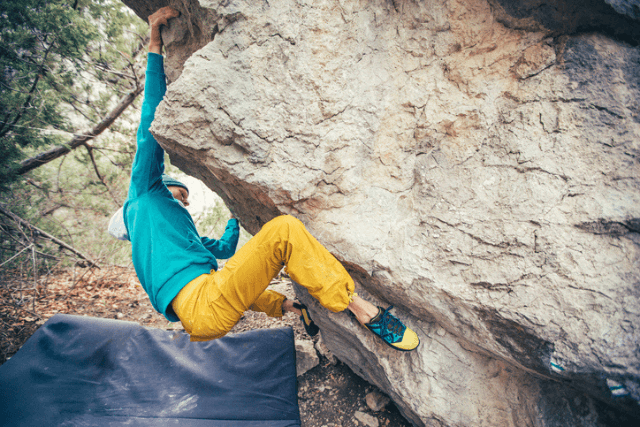
Bovey Woods comprises of five main areas including Shaptor Rock, Lower Shaptor, Rock Copse, Bearacleave and Stonelands Waste.
Easier/beginner bouldering route: Love Bugs (V1) on Bearacleave
Intermediate bouldering route: Mornington Crescent (V3) on Bearacleave
North & South Moors Tors
The North and South Tors on the high moorland provide even more action.
Notable tors include Great Links Tor, Bench Tor, Combshead Tor, Down Tor, Sheeps Tor and Foggintor Quarry.
Nothing can beat the sun on your back and a worthy rockface ahead.
Foggintor Quarry
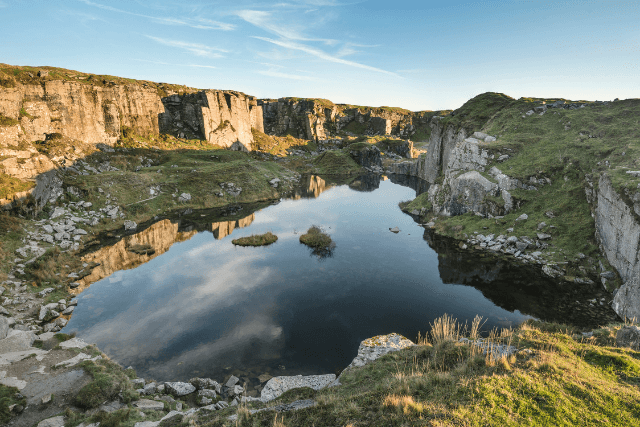
Not a tor, but still a jewel in Dartmoor’s climbing crown. It’s a great spot in the colder and windier months too.
Easier/beginner trad route: Swan Lake (HS 4a)
Expert trad route: Limestone Cowboys (E4 6b)
Combshead Tor
Combshead Tor and Cuckoo Rock is a prime location for bouldering, home to over 150 problems.
Easier/beginner bouldering route: Flake Crack (V0)
Expert bouldering route: Proof of Concept (V5)
Dewerstone
Lastly, but certainly not least is Dewerstone. Located in the southwest corner of Dartmoor, Dewerstone is one of Dartmoor’s most extensive crags.
The views from Dewerstone look out over the Dewerstone Valley, offering up some unforgettable sights.
Please note: Seasonal restrictions from 21 April to 30 June due to nesting kestrels on Upper Raven Buttress.
Easier/beginner trad route: Central Groove (HS 4b) on The Devil’s Rock
Expert trad route: Scimitar (E1 5b) on The Devil’s Rock
Things to know before you go:
1. There’s no sport climbing in Dartmoor
Sport climbing involves placing permanent bolts in the rockface, however this is expressly forbidden on Dartmoor granite.
You can enjoy bouldering which requires no protection, as well as traditional (trad) climbing on Dartmoor.
The latter only involves placing protection like chocks and camming devices, which simply wedge between the rock and don’t penetrate it.
2. Don’t remove plants or lichens from the rock
Dartmoor is a national park after all, so it’s really important to leave the beautiful Dartmoor granite as you found it.
Wherever possible, don’t remove any natural growth from the rock and take care when placing your protection.
3. Keep clear of the livestock
Across the whole of Dartmoor, you’ll come across sheep, cows and the lovely Dartmoor ponies. Please always give livestock and wildlife plenty of room when you’re travelling to and from your chosen crags.
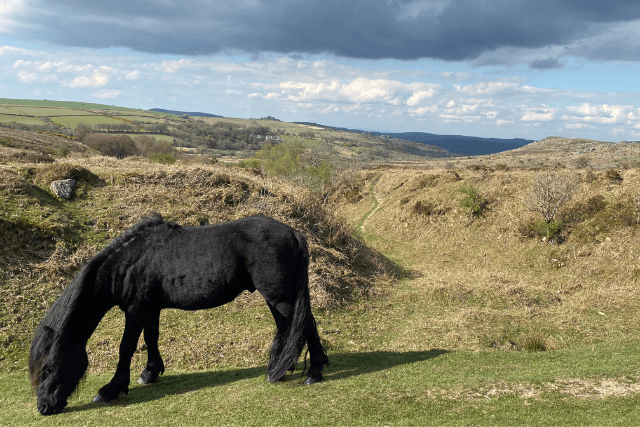
4. Look after your dogs on Dartmoor
By all means, bring your pet pal along on your bouldering adventures! But just make sure they are under control when your back is turned and you’re busy figuring out your next move.
Whether that’s ensuring your dog is okay around other climbers, dogs, or nearby livestock. And don’t forget to pick up after them too.
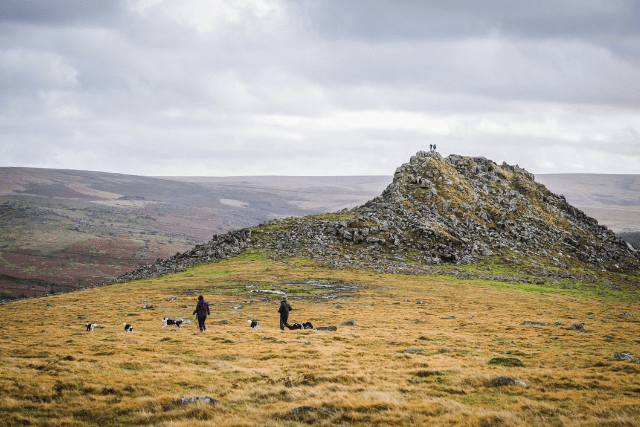
5. Research your climbing spot
Be aware that there are archaeological features scattered across Dartmoor. Know where you’re going and respect old buildings and ruins – don’t climb them.
6. Leave Dartmoor as you found it
Leave as little trace of your visit as you can. This means bringing any litter home, and using a chalk ball or liquid chalk instead of regular.
A chalk ball or liquid chalk limit the build up on the holds, so the rock needs less brushing. If you do need to brush the rock, use a softer brush so it’s more gentle on the granite.
7. Bring your bouldering pad
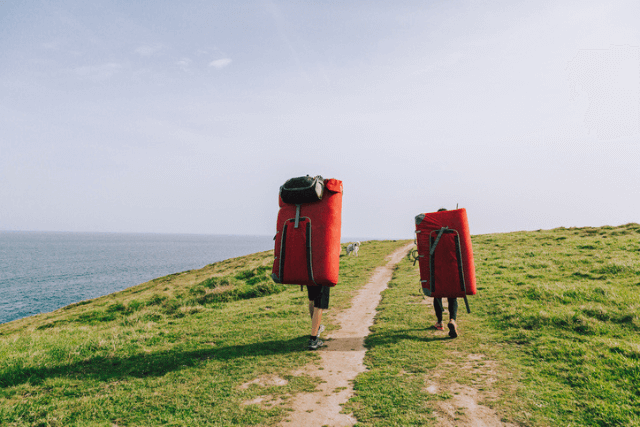
Bringing your bouldering pad with you is kind of a given anyway when you’re approaching new climbs. But it’s especially important on Dartmoor.
You may find base erosion at some tors and crags, where the soil at the base of climbs is fragile, and a pad will help protect against further erosion, as well as cushion you!
8. Dartmoor granite can be unforgiving
Lots of the Dartmoor climbs involve very sharp edges and crystals in the granite. Just be extra careful with your hand and footwork.
When is best to go?
Unlike many other climbing spots, Dartmoor is great in the height of summer. The elevated and exposed positions of the tors will mean you can stay cool on hot days thanks to the steady wind.
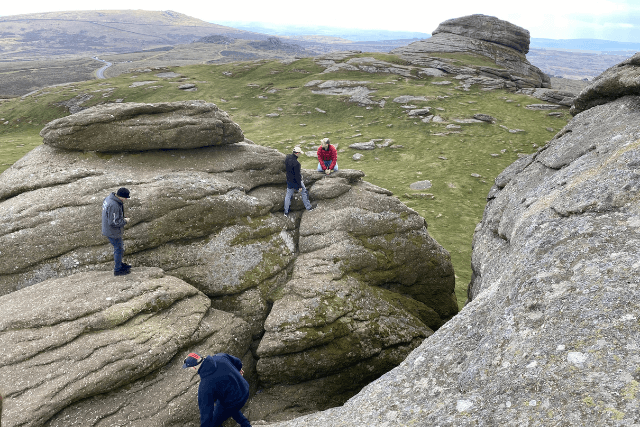
The woodland areas like Bovey Valley are best avoided in summer. They can get really overgrown and covered in nettles which doesn’t make for a great climbing experience!
Rock climbing and bouldering experience providers in Dartmoor
Below is a list of experience providers who can offer guided outings across Dartmoor, safely introducing you to the sport:
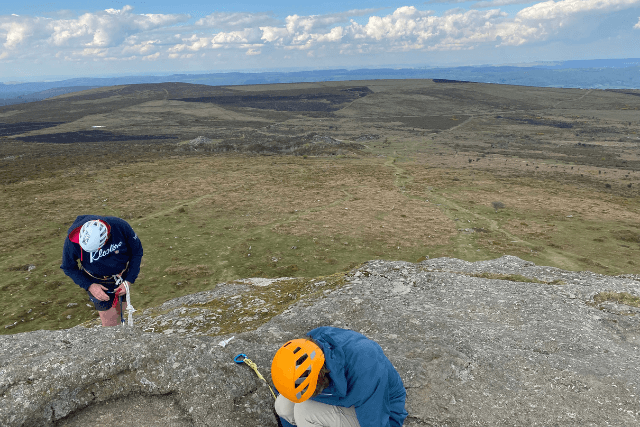
More Dartmoor climbing and bouldering resources
For more climbing guides and information on routes, head to Javu. Here you’ll find a Dartmoor bouldering guide and many other South West area guides.
Enjoy your own bouldering break to Dartmoor National Park
Place yourself at the centre of the action in Dartmoor!
At Helpful Holidays, we can offer a wide range of cottages in Dartmoor for your climbing and bouldering adventures.
Below is a beautiful cottage, Cullaford Cottage (Ref. 975826), resting in Scorriton near Ashburton, which would make a wonderful bouldering base.
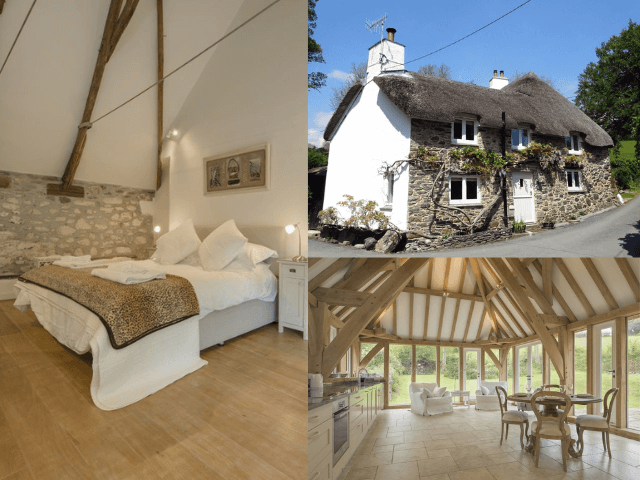
Still feeling adventurous? Take a look at our article on top things to do in Exmoor National Park, another of Devon’s greatest natural playgrounds.
We’ve also got a delightful blog about Dartmoor walks, perfect for those seeking more serene activities.
Disclaimer
It goes without saying – but we’ll say it just in case – that climbing in all its forms (trad, bouldering, sport etc) is a dangerous sport which can lead to serious injury or worse.
This article/blog should not be used as a training guide or guide book. Please seek professional trainers and guides if you are new to the sport. We assume no responsibility for the safety of any readers of this article.
Image credits: Sirenz Lorraine – CC BY-ND 2.0